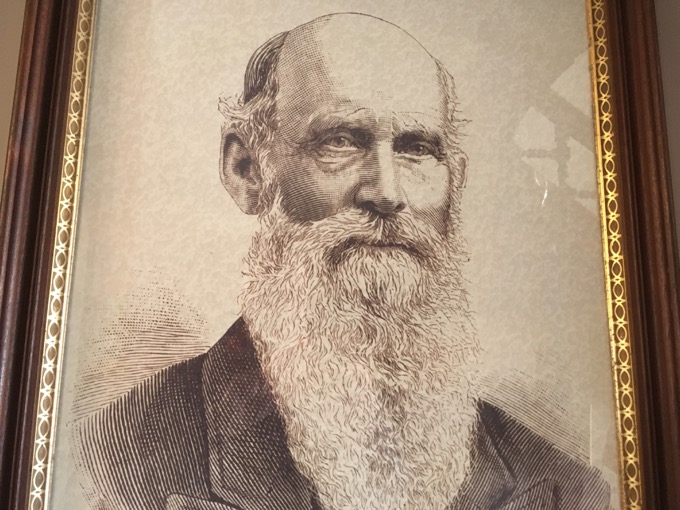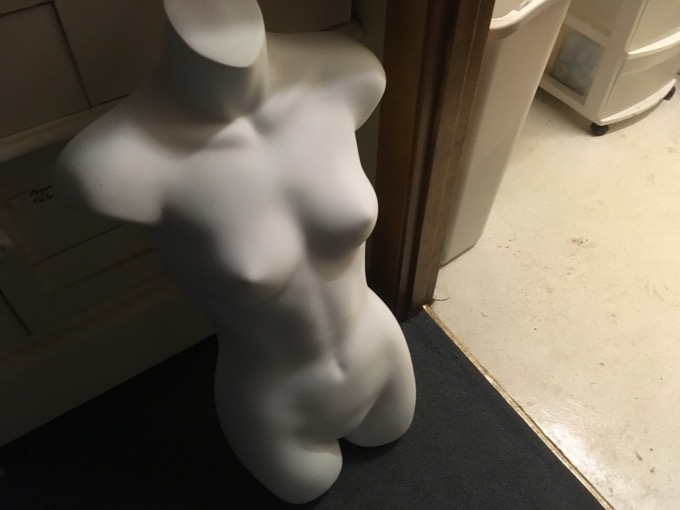Spring Has Sprung
Stafford (Google Maps location)
March 12, 2017
Most of you realize that one of the reasons Connecticut has many hundreds of museums is because each of our 169 towns operates as its own little fiefdom. Therefore, almost every town has its own town history museum. That’s 169 museums right there. (Not quite, but pretty close.) What’s astounding to me, perhaps the only person hellbent on visiting them all, is just how good so many of them are.

I can’t tell you how many times I’ve parked the car and trudged up the steps into a new-to-me town historical society thinking, “here we go… George Washington slept here, they used to make stuff here, kids played with these terrifying dolls here…” and within minutes I realize that many volunteers have spent thousands of hours piecing together their hometown’s unique history in a coherent, interesting, and oftentimes fun way.

The church next door
Such was the case (again) at the Stafford Historical Society’s museum in downtown Stafford Springs. (Stafford Springs being the downtown section of Stafford, of course.)
I often say that I bring Damian along on these visits for five reasons:
1. To “use” him as my excuse for taking a ton of pictures
2. To “use” him as an excuse to get a quicker tour or as an escape plan
3. To expose him to more people and more of the world
4. To expose people to him and his unique genetic syndrome
5. To give my wife and other son a break from Damian’s constant need for care and attention
Four of those reasons hold true almost all the time. However, there are times when the second one (an excuse to not get “stuck” someplace “boring”) backfires.

I never learned what the “OPERA” was from
Such was the case (again) at the Stafford Historical Society’s museum in downtown Stafford Springs. (You know what I mean now.)
Stafford is one of those towns about which I knew nothing before beginning to explore it for my town “completion” project. In fact, I can’t remember if I’d ever been “downtown” before in my life. It’s charming and far more vibrant than I’d ever known. Hip coffee shops, a super high-end men’s fashion company, cool architecture, a cidery, a (coming soon) brewery, and an Art Walk event every other week in the summer.

And its town history museum had maybe 25 other visitors during my visit. That’s about 23 more than usual. Good for them.
The Stafford Historical Society was founded in 1962 by a group of local citizens who were interested in preserving Stafford’s history. Its home is beautiful. It previously served as the town Library, and prior to that served as the probate judge’s office, offices of the Converse Woolen Co, and as the bottling house of the Stafford Mineral Waters Co. dating back to its construction in 1885.

Ah yes, those Stafford Springs! The original “Stafford Springs Mineral Spring” thing is outside, between the museum and the equally impressive Grace Episcopal Church.
The museum has two floors of exhibits and I’m not sure what is permanent and what isn’t, but I don’t think you’ll find that too important. Damian and I were greeted and welcomed and cajoled into asking questions immediately upon entering the building.

For typical visitors, that’s great. For Damian, we needed some time to acclimate so we scurried upstairs to check out the exhibits there first – away from people.
The highlight of the second floor is the B. Schwanda and Sons button display. Back in the day, before plastic buttons, buttons were beautiful. Particularly beautiful were ocean pearl buttons. And one company in particular, B. Schwanda and Sons, made particularly particular buttons.

Ocean pearl eagle. Rad.
Right here in Stafford. I just spent some time learning about mother of pearl – the raw material used for these buttons. The substance is called nacre, and it’s actually found in a whole slew of mollusks.
Back in the early 1900’s, beautiful buttons were all the rage. The nacre was mostly harvested off of Australia and brought back to the eastern US. I just read some articles lamenting the dying off of the industry, but c’mon. Overfishing, the tranporation to get the raw material to Connecticut… that industry wasn’t in for the long haul no matter what.

I found this JSTOR page interesting; what with the “semi-civilized natives” and all.
These button geniuses were all from what is now the Czech Republic for some weird reason, but had emigrated to America before the Nazis swooped in and set up shop in New York and Stafford. Just some lovely stuff and a pretty neat story.

Original button lathe thing from Czechoslovakia
The rest of the upstairs contained some stuff about local baseball heroes, none of which I’ve ever heard of and an exhibit that was basically a Stafford pharmacy from nearly 100 years ago.
I guess HIPAA laws don’t apply to the deceased, as the museum displays prescriptions from back in the day.

Damian and I ventured back downstairs to the main exhibits. There are a few separate rooms here, but the premise is to simply tell the story of Stafford. Of course, one of the biggest stories of Stafford would have to be the springs.

The springhouse
The local Nipmuck and Podunk Indians first used the mineral springs as a watering spa. They claimed it had medicinal and curative powers. John Adams was even convinced of this nonsense and visited in 1771 to partake. Stafford Springs was a noted health resort comparable with Poland Springs in Maine or Satatoga Springs in New York.
The Springs aren’t open anymore, but the little “spring houses” still stand. If you want local spring water, you can find one on route 32 in Willington. I cannot vouch for its curative powers.

Random display
The first floor of the museum contains all the stuff you’d expect from a town history museum. But it does also hold some surprises. Like this dude:

I had never heard of Ephraim Hyde before my visit. The park behind the museum is called Hyde Park, sure, but who was Hyde?
Ephraim Hyde was Stafford through and through. Born, lived, and died here. Was involved in a bunch of businesses and prison reforms and served as the state’s Lieutenant Governor, and… and…

Was tight with the Storrs boys and convinced them to start an agricultural concern over in the middle of nowhere to the east of Stafford. Hyde got a lot of flack for the idea, but the Storrs School was established.
There’s a nice trail at the other end of Hyde Park. Damian and I hiked it.
Now that little place is the only school to have one both the men’s and women’s basketball championships in the same year. And they’ve done it twice. I’m sure that’s exactly what Ephraim Hyde had in mind back in the day.

There are several exhibits proudly touting the town’s former industries. Bottle makers (to aide the spring water folks), china makers, and the like. I became particularly interested in a display featuring milky quartz.
At the time I thought the whole quartz thing was weird and ancient. I later learned that mineral hunters consider West Stafford a hotbed for such things. There is a trail to the mined areas and Damian and I hiked it, here.

You can no longer legally dig for this stuff, and really, I’d assume most of it has been picked out of the hill. You see? You had no idea that Stafford, CT was a draw for rock diggers.

You probably did know it was a draw for race car fans. The Stafford Agricultural Fair began here in 1870 and almost always featured racing – horse racing. Some of the best horses in the east ran here.

Dirt track auto racing began in 1948 and in the time since, Stafford Motor Speedway has come to host NASCAR races at all levels. Races go off on Friday nights all summer long and I guess people go to them.

I love this… “Congress of Daredevils.”
Actually, as part of my Stafford “completion” project, I plan on going to Stafford Motor Speedway. It’ll be a totally new experience for me, that’s for sure. I’ll bring Calvin too. Is it loud? I’d guess it’s loud. I hope it’s not too loud.
As with all proud town history museums, the folks in Stafford display some rather… specific? Odd? items. Here are a few:

This a remnant of the plush fabric of the pulpit from a church that was destroyed in a flood in 1877. It’s about 1″x2″.

This? This is a section of railing that used to be along the street in front of a church.

This here is a red cross uniform worn by the wife of Judge Joel Reed. Such a nice mannequin, and…

SHE HAS NO LEGS, AHHHHHH

Stafford is super proud of this

Old dairy bottles on an old sleigh

Rule of thumb: Always ask to use the restroom in these old places. You’ll never know what you’ll stumble upon on your way.
I was very impressed by this museum. Just big enough to be worth anyone’s while, but not so big as to lose people’s interest. Housed in a really cool building and staffed by passionate, knowledgeable volunteers.
The only thing I’m kicking myself is that I lost/tossed the explanation for the beautiful stained glass windows at the entrance. I want to say they are original to the building. Actually, I’m pretty sure someone from the society will post the answer in the comments below.
They’re that good.

![]()

 David Viara says
David Viara says
December 23, 2019 at 7:16 amLooking for info on Stafford Springs House/Hotel. My aunt and uncle( Gladys and Gordon Martin) lived there in the 1950’s. They lived there when the building was destroyed by fire and after the fire they relocated to Springfield Mass . I was just a kid at the time but I remember going to visit and drinking water from the spring. I haven’t had any success getting info on the InterNet about the fire and hoped maybe you could assist.
 RDP says
RDP says
July 28, 2021 at 9:21 amYou don’t say who the town was named for. Why is it “Stafford Springs?”
 Martha Keener says
Martha Keener says
March 12, 2022 at 2:37 pmDo you have any information on Hendricks Hallet Whitman (1884-1950)? I believe he was involved in early wool manufacturing.